Important note: The aim of this post is to clarify some of the terms used and to help practitioners create their own routines and procedures. However, always seek guidance from your regulatory bodies, local authority and environmental health officer in the first instance. Last updated March 2024.
The article was originally written in 2011 and was a joint effort by Juliet Robertson and Jason Tetro, a hygiene researcher at Ottawa University. He writes an upbeat blog The Germ Guy which will give you lots of useful information. Thanks Jason, for all your input and advice!
Public Health Scotland have updated their guidance in March 2024. It is now called Health Protection in Children and Young People Settings, including Education. The hand hygiene guidance is tucked away in the Preventing and Controlling Infections Section, specifically the Standard infection control precautions (SICPs) section. I’m not providing a direct link as this could easily change. The guidance specifically for outdoor nurseries is significantly more stringent and appears to remain in place.
I’m sure almost all of us would agree that good hygiene routines and practice is essential in any nursery, indoors or out. Soap and running water is best. It’s natural and it’s effective when hands are washed carefully and properly.
Schools and settings should not feel that they must stick to trips where public toilets are in the immediate vicinity. Children need to learn to manage toileting, handwashing and other personal hygiene where such facilities do not exist or do not work. For expeditions and many walks, it is unreasonable and impractical to have to have a place with running water facilities every half a mile or so. Imagine what Ben Nevis and all our other Scottish hills would look like with taps installed at regular intervals up the paths!
Hand hygiene outdoors
What is “Running Water”?
By running water, this means fresh, clean water that is not stagnant. It can come from a bottle. It does not have to come from a tap. There has to be low turbidity, low levels of organic carbon, no evidence of microbial growth and have either a pleasing or no odour. This is fairly common sense when it comes to water. Cross-contamination needs to be avoided. Thus the good old-fashioned bowl on sticks at camps in the Seventies is now a no-no, according to infection control specialists.
Likewise, each child must carry their own personal hand towel for drying their hands or use paper towels. This does debunk the myth that running water and soap is less wasteful than handwipes outside.
In remote locations where running water is not available, the health and safety advice is to take reasonable, practical steps to minimise the risk. The definitive guide is the World Health Organisation Hand Hygiene Guidelines. This is an interesting document in that there are not blanket statements but advice which includes the need to take account of local cultures and contexts. In Section 10.3, the guidelines state the need for better research methods, particularly in relation to ordinary circumstances rather than laboratory controlled experiments. A good example of an alternative approach taken in other countries is the use of tippy taps which are easily made from canisters, paracord and a wooden frame. Interestingly, this is becoming increasingly popular on static greenspace sites in the UK. Do remember to check that your children are physically able to use one. The gushing of water can be reduced by replacing the cap with a one with a smaller hole drilled in it and an air hole at the top of the canister. Alternatively, a watering can may be preferable. Experiment until you find something to your liking.
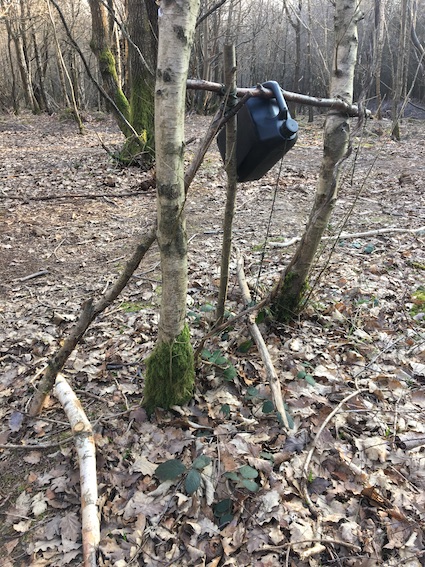
As part of the COVID-19 pandemic, a 9-year old boy, Stephen Wamukota, from Kenya invented a hand washing machine which adopts a similar process for enabling hands free washing outside. Whilst this is a lovely invention, remember that hands free is not necessary within Scotland. Using the correct hand washing technique with soap and running water kills the bacterial and viruses and prevents transmission.
Why is soap and water sufficient for hand washing?
This is a common question, particularly now we have COVID-19 within our communities world-wide. The Guardian has this article that explains the science behind soap and water.
Should we be purifying our water?
There are many ways of purifying water such as evaporating and distilling it. This should not be necessary on day visits or places where you can refill with tap water. It may be a consideration for multi-day expeditions or school visits to some countries. There are many different types of filter pumps on the market. Antimicrobials such as ethanol, chlorine and chlorohexidine gluconate can be added. Advice should always be sought from your local authority outdoor education or health and safety team over use of purification methods.
What are the issues with hand rubs and sanitisers?
Hand rubs and sanitisers are only effective on clean hands that have no visible contamination. Essentially they make clean hands ultra clean! The 99% claim on the package is only in lab tests and that effectiveness in the real world is considerably less, whether the active ingredient is alcohol or another antimicrobial chemical. Moreover, hand sanitisers work best to remove bacteria, viruses and fungi that are transient on the skin, that is, they can be spread easily through touch. If hands are grossly contaminated, hand sanitisers will not be able to return hands to safety as there needs to be friction and pressure to remove the contamination from the skin. The use of a wetted fabric such as towel or wet naps and/or nappy wipes can work well. A research review of the use of rinse-free hand wash in pre-schools and schools suggests the effectiveness is marginal and more research is needed.
There are some cultural issues associated with hand rubs. These focus on the use of alcohol rather than risks around ingestion. There are now a plethora of non-alcohol based sanitisers that have a longer lasting effect in terms of disinfection.
In the March 2024 guidance changes
- The use of a hand rub is now permitted on hands that are not visibly contaminated and their use by children should always be supervised – BUT – this does not seem to be the case for outdoor nurseries
2. The time it takes to wash one’s hands with soap and water continues to be confusing. The whole process from start to finish should take at least forty seconds with the actual rubbing of the hands taking 15-20 seconds – the time it takes to sing Happy Birthday twice. To avoid confusion, watch the NHS video.
3. There is now a section called Specific settings and populations: additional health protection considerations. Whilst the guidance is specific to Scotland but you are also advised see further info in the UK-wide guidance. Both include reference to:
- early years or pre-school children (ages 0 to 5)
- special educational needs
- additional support needs and disabilities
- residential settings
- travel health
- outdoor learning, including forest schools and educational visits
This is the page you need to pay very close attention to. Be aware that the stipulation around the use of warm water is not mentioned on this page BUT there is signposting to Out to Play – Section 5.5 about handwashing references the need to use warm water (based on previous guidance)
What about handwipes?
According to Out to Play Section 5.5 hand wipes may be used, but hands should be washed at the first available opportunity and certainly before and after a number of situations. This need not be a problem.. tepid water is sufficient and wrapping bubblewrap around a water bottle keeps water sufficiently warm for a morning. Below is Mucky Boots Nature Kindergarten‘s beautiful DIY approach:

Through my own work with children, I have noticed that outside, there are instances where hand wipes are ineffective. The first is when a child’s hands are covered in mud or there’s soil under the fingernails. In other words, the visual contamination is significant. The other is on a beach where the sand particles seem to be particularly resistant to being removed.
The long term effects of using wipes are purportedly unknown. It may seem like a strange assumption given that thousands of babies’ bottoms are wiped daily for over two years whilst having their nappies changed. However from an environmental perspective, wet wipes are not ideal and care should be taken to use biodegradable options, if you feel you must use them. There is an increasing move towards using cloth towels. When this happens, you need systems in place to ensure there is no cross-contamination happening by children using a towel belonging to another child or by towels being stored in such a way that they touch other towels. Remember to use biodegradable soap – pump action bottles are often advised and antibacterial soap is not necessary.

Can children clean their hands properly without an adult present?
For children to wash their hands in the correct manner, they need clear support until the habit is embedded. Adults need to model the process. Photo prompts, a song and other reminders may be needed. This is best learned prior to the colder winter months, when the temperatures go down and the body chill times go up. Asking parents to help reinforce the correct procedures at home can also speed up the learning process. This is also why arguably warm water makes a difference. Children will need to be shown how to do this in ways that minimises water use especially if you have to carry water onto your site on a daily basis. Whilst the example from the 2-3yr old sink is indoors at the Cowgate U5s Centre, have a look at the use of real photos in the hand washing sequence which make the actions needed very clear.
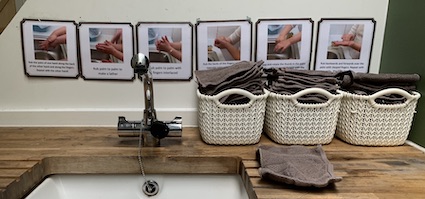
What about parental viewpoints on hand hygiene?
Out to Play recommends that settings make parents fully aware about all infection control procedures. This will include the outdoors both within the designated outdoor space and for off-site trips as well as indoors.
Contact with animals
The UK-wide guidance includes reference about hand washing in the Farms and Zoos section. But this is also relevant to onsite contact with animals, their feed, bedding, etc. Check out the expectations and follow these. If your setting has animals, then it is likely that the same stringent guidelines apply. Hand rubs and sanitisers are insufficient.
The main points to remember
- Ensure advice is available to parents about hand hygiene outdoors in the designated space and for off-site trips. Parents should know that they can request their child uses soap and warm running water at all times and staff must ensure this happens.
- Consider hand hygiene in school grounds or outdoor space. Can children easily access running water and soap? What happens to the paper towels and hand wipes, once used? Is there a bin or bag nearby? What happens to the used water… is there a soakaway or another method for disposing safely of the grey water?
- At all times, encourage children to use the proper techniques for getting hands really clean and eventually being able to do this independently of adults.
- If your setting still uses handwipes and/or sanitisers, think carefully about the types which are most suitable and seek advice here. Handwashing with soap and water is best practice.
- Schools and nurseries can still visit places where public toilet facilities may not exist. However, this should be put in your risk benefit assessment and clear routines and procedures must be in place that all staff, volunteers and children know and can easily follow.
- Always take a large bottle of clean water, soap and some cloth or paper towels on a day trip, even if the decision to use handwipes has been taken. In the event of a child getting very soiled hands, then the soap and water can be used.
- Keep checking the research. Then you can ensure you are knowledgeable and up-to-date.
What does an outdoor hand hygiene station look like?
There are many options for hand hygiene for all budgets and situations. Everyone has a different opinion as to what works well, so you will need to bear in mind that the comments below are based upon my experience along with visits to many different settings, including outdoor ones.
Kiddiwash sinks. These are rip-roaringly expensive and whilst can be carried inside and out, they are not suitable for situations where you are carrying kit in a backpack. However their website has lots of information that is relatively jargon-free. One advantage is that they collect the washed water which can be disposed of down a traditional sink.
Igloo containers. These hold much more water than Kiddiwash sinks and are useful for static outdoor nurseries with no access to mains water. They come in a two sizes. Although originally used for keeping ice from melting, their insulating properties mean they keep warm water warm. The link above takes you to a new model specifically for hand washing. Thanks to Cameron Sprague, who works at Stramash Fort William for supplying the photo below. You will notice a collection bucket below the igloo container to stop water spilling everywhere.
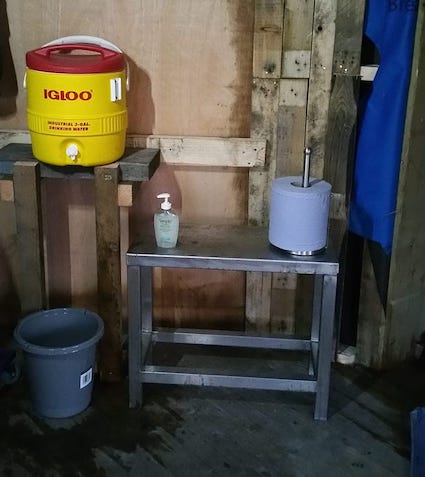
Cameron is a great experimenter and his first system was this foot pump system. It was rigged to a sink with a drain and some insulated warm water.
Solar showers. Several years ago I experimented with a range of models. I didn’t find any I truly liked that fostered independent use by a child. But more types may have come onto the market and pressurised showers are becoming more commonplace. They can often take a lot of water but in Scotland you cannot rely upon the sun to keep the water warm. You will need to insulate the holder.
Water holders. These rely on a plastic stick being moved up to release water. They are particularly good for children who cannot manage to turn a tap or press a lever. These are now hard to get hold of, but are commonplace in Lithuania. However being lightweight and cheap, they are extremely useful. You can see an example below used in a static set up at Oban Stramash Outdoor Nursery. I have also wrapped these water holders onto tree trunks using shockcord elastic. It is possible to make your own using an Andy Handy Water Dispenser available from the Woodlore Shop.
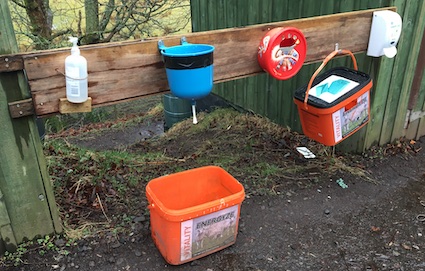
Spa Taps are a wonderful contraption which allows three different ways of accessing water. Children can use this independently and they fit a broad range of bottles including soft and hard bottles and big bottles too. This is very good for schools and nurseries who visit woods weekly but set up from scratch each time. Some advantages include:
- They are useable by very young children – you simply touch the silicone to get the water out or remove the bung so there is a trickle of water.
- They use the minimum of water, so this saves water and also saves on carrying a lot of water onto a site. I’m finding that 100ml per 3 or 4 yr old child is plenty even when children are new to the system. The Spa Tap website suggests 50ml is possible with older children.
- On their website you can donate a Spa Tap to another school that needs one for their hand hygiene where water is scarce.
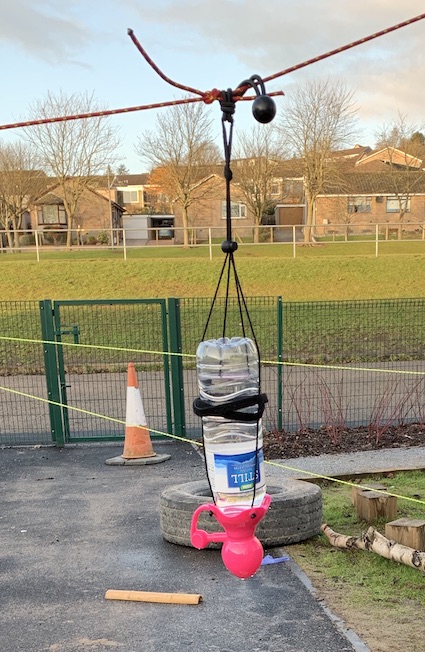
I have created a Hand Hygiene Pinterest board with examples of the different methods I have encountered. You can see an annotated photo of how a Spa Tap washing line approach can be set up, which is incredibly quick, simple and low cost. This will need adjusted for your country’s specific requirements, e.g. a lidded bin instead of a plastic bag in England.
Thrive Outdoors have created outdoor hand hygiene guidance to help you consider what you need for your own outdoor space.
Muddy Faces now have a comprehensive range of hand washing items from buckets, sinks, containers and so on. They have also developed a specific unit for use outside in playgrounds that can hold a lot of water in one go.
Below is a video of practical examples from Scottish outdoor nurseries – the Willow Den bucket for hand towels is excellent and you can see the Igloo hand wash container in action too:
Learning how to wash your hands.
Health Protection Scotland has a suite of resources on this subject. However this video is quite funky. NHS has also produced this video which has clear visuals. Baltic Street Adventure Playground have also created a dance version and would encourage children to do the same 🙂 Stramash Outdoor Nurseries have a great range of policies which include hand hygiene which you can view.
Reducing paper towel waste
I have been signposted to this YouTube Video. By shaking your hands 12 times and folding a paper towel, only one per wash is needed. I did a lot of experimenting with this in early 2021. The less you shake your hands, the more paper towels you need. However, discussions with an environmental health officer and a person from the infection control team at Grampian NHS both revealed a similar concern about contaminated droplets being spread through shaking. This seems a wee bit OTT given that in theory the hands should have been thoroughly washing in line with best practice, thus they should be clean and the risk minimised.
Finally, this blog post has been written in good faith. Any other experiences or advice or links to hand hygiene research, especially in outdoor contexts are always welcomed.




















Such great information! My sister swears by those hand sanitizers but I just KNEW they weren’t cutting it!
Thanks for taking the time to put this together and share it with all of us.
Very comprehensive and informative – thank you! I will print out and share at work. My bane is muddy shoes especially in KS2. Children rarely have a second pair once they are 10 and are forced to go ‘shoeless’ indoors. We have tried telling parents to supply wellies or old trainers and a plastic bag – but this goes unheeded for whatever reason. The mud returns to their hands, clothes, not to mention carpets. Ugh! And I am always in trouble with cleaners. Any suggestions?
Hi Alix – I think there’s no easy solution that springs to my mind but others may have some good suggestions. I think muddy footwear needs to be left at the door or in a cloak room. Depending on the nature of the footwear, having bowls which children step in, that can help rinse off the mud can help. Mud Daddy pressurised containers come with a brush which can also be useful for removing mud, but these are generally only 5-12l in size.
I’m reviewing our handwashing procedure in preparation for re-opening after the Covid-19 lockdown. Thank you for such concise, easy to access information. Much love x
Thanks Nicki – all the best with your work!